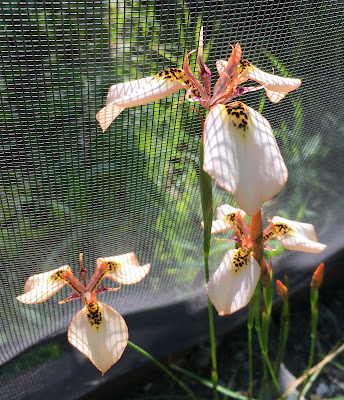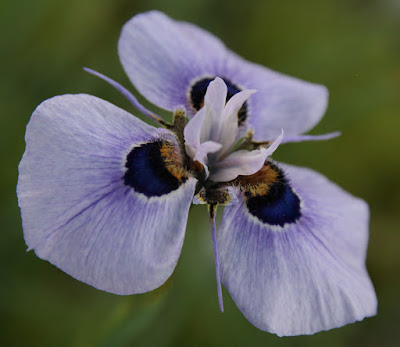Seed parent: MM 09-02a (aristata X villosa)
Pollen parent: Moraea tulbaghensis with blue eye
Usually this sort of cross would give an orange flower, so I am surprised that this one is light purple. I hope some of its siblings will bloom next year, so I can see if we get different colors.
MM 14-37a.
Thursday, June 29, 2017
Moraea MM 14-21
Seed parent: Moraea villosa form H
Pollen parent: Moraea tulbaghensis with green eye
Usually a cross like this would make an orange flower, but this time I got a mix.
MM 14-21a. Nice colors, but it looks like just M. villosa.
14-21b
14-21c
Pollen parent: Moraea tulbaghensis with green eye
Usually a cross like this would make an orange flower, but this time I got a mix.
MM 14-21a. Nice colors, but it looks like just M. villosa.
14-21b
14-21c
Moraea MM 14-01
Seed parent: Moraea tripetala
Pollen parent: Moraea neopavonia 'Summerfield'
Weird! The flower has much of the shape of M. tripetala, and those polka dots in the center are from Moraea neopavonia, but where's the eye?
MM 14-01a
MM 14-01b. Very similar to form a, but the inner tepals are shorter and darker.
MM 14-01c
MM 14-01d
Pollen parent: Moraea neopavonia 'Summerfield'
Weird! The flower has much of the shape of M. tripetala, and those polka dots in the center are from Moraea neopavonia, but where's the eye?
MM 14-01a
The spotted eyes are so interesting that I almost didn't notice the beautiful magenta color of the inner tepals.
MM 14-01c
MM 14-01d
Moraea MM 13-197
Seed parent: Moraea lurida
Pollen parent: Moraea villosa form H
Wow. Usually hybrids with M. villosa look mostly like villosa, but not this one. The cup is orange with maroon veins and very short hairs, the eye is mostly black with a little spot of yellow. The tepals have fairly prominent purple veins. This is one weird-looking flower.
MM 13-197a.
MM 13-197b. A clearer golden cup with black speckles, and even more prominent veins. This is one weird flower.
MM 13-197c. Like form a, but with more yellow in the inner tepals, and the tepal tips are rolled differently.
MM 13-197d. Huge, very dark maroon inner tepals.
MM 13-197e. Wow, look how dark the eyes and inner tepals are in this flower!
Pollen parent: Moraea villosa form H
Wow. Usually hybrids with M. villosa look mostly like villosa, but not this one. The cup is orange with maroon veins and very short hairs, the eye is mostly black with a little spot of yellow. The tepals have fairly prominent purple veins. This is one weird-looking flower.
MM 13-197a.
MM 13-197b. A clearer golden cup with black speckles, and even more prominent veins. This is one weird flower.
This one is growing in the same spot as 13-197b, but I think it may be a different plant.
MM 13-197c. Like form a, but with more yellow in the inner tepals, and the tepal tips are rolled differently.
MM 13-197d. Huge, very dark maroon inner tepals.
MM 13-197e. Wow, look how dark the eyes and inner tepals are in this flower!
Moraea MM 13-196
Seed parent: Moraea tripetala
Pollen parent: Moraea bellendenii
This is a hybrid that's interesting because of what didn't happen. Hybrids with M. tripetala often have prominent stripes on the tepals, and hybrids with M. bellendenii often have dark rings. Combine the two and you get...a plain pale yellow flower, slightly bigger than typical bellendenii. Usually tripetala hybrids are shaped mostly like tripetala, but this one is more like bellendenii. If tripetala weren't the seed parent. I'd probably assume this was a light version of M. bellendenii.
MM 13-196a.
Pollen parent: Moraea bellendenii
This is a hybrid that's interesting because of what didn't happen. Hybrids with M. tripetala often have prominent stripes on the tepals, and hybrids with M. bellendenii often have dark rings. Combine the two and you get...a plain pale yellow flower, slightly bigger than typical bellendenii. Usually tripetala hybrids are shaped mostly like tripetala, but this one is more like bellendenii. If tripetala weren't the seed parent. I'd probably assume this was a light version of M. bellendenii.
MM 13-196a.
Moraea MM 13-195
Seed parent: Moraea lurida
Pollen parent: MM 09-02a (aristata X villosa)
What a pleasant surprise! I spent years trying to make hybrids with M. lurida, without success – they always turned out to be self-pollinated. In 2013 I made a last effort, carefully emasculating the flowers and protecting them from pollination. When they set seeds, I assumed the flowers had somehow self-pollinated anyway. And some of them had. But then this flower opened...
MM 13-195a. How interesting. The cup is rusty orange with some dark speckles toward the base. The hairs in it are very short. The inner tepals are almost solid maroon, which comes from M. lurida. The eyes are probably the strangest part – they are yellow, heavily outlined in black. And just to top things off, there are dark veins on the tepals. I can't wait to see how the second generation hybrids will look. You get daytime and night-time photos here.
MM 13-195b. The cup is yellow in this one, with some maroon veins.
Pollen parent: MM 09-02a (aristata X villosa)
What a pleasant surprise! I spent years trying to make hybrids with M. lurida, without success – they always turned out to be self-pollinated. In 2013 I made a last effort, carefully emasculating the flowers and protecting them from pollination. When they set seeds, I assumed the flowers had somehow self-pollinated anyway. And some of them had. But then this flower opened...
MM 13-195a. How interesting. The cup is rusty orange with some dark speckles toward the base. The hairs in it are very short. The inner tepals are almost solid maroon, which comes from M. lurida. The eyes are probably the strangest part – they are yellow, heavily outlined in black. And just to top things off, there are dark veins on the tepals. I can't wait to see how the second generation hybrids will look. You get daytime and night-time photos here.
MM 13-195b. The cup is yellow in this one, with some maroon veins.
Wednesday, June 28, 2017
Moraea MM 13-192
Seed parent: Moraea MM 03-98a (M. atropunctata X calcicola)
Pollen parent: Moraea "longiaristata" with few spots
I wanted to see what would happen if I mixed these two spotted plants, and the results were very interesting. If you look closely, you'll see the flower has both blue and pale pink spots/streaks. Unfortunately, it's small and didn't set seeds well (only one cross out of about six worked). But I'll keep trying, because it's a very distinctive looking flower.
MM 13-192a.
Pollen parent: Moraea "longiaristata" with few spots
I wanted to see what would happen if I mixed these two spotted plants, and the results were very interesting. If you look closely, you'll see the flower has both blue and pale pink spots/streaks. Unfortunately, it's small and didn't set seeds well (only one cross out of about six worked). But I'll keep trying, because it's a very distinctive looking flower.
MM 13-192a.
Moraea MM 13-186
Seed parent: MM 03-04b
Pollen parent: Moraea villosa form C
This was an experiment to see what would happen if I mixed villosa, calcicola, and aristata. The result is mostly villosa-like.
MM 13-186a.
MM 13-186b.
Pollen parent: Moraea villosa form C
This was an experiment to see what would happen if I mixed villosa, calcicola, and aristata. The result is mostly villosa-like.
MM 13-186a.
MM 13-186b.
Moraea MM 13-182
Seed parent: MM 03-04a (M. aristata X calcicola)
Pollen parent: MM 11-161b ((M. atropunctata? X neopavonia) X (neopavonia x villosa))
I crossed a pale purple flower with a rich brownish-red one, hoping to get a lighter red. Instead it came out pale purple.
MM 13-182a.
Pollen parent: MM 11-161b ((M. atropunctata? X neopavonia) X (neopavonia x villosa))
I crossed a pale purple flower with a rich brownish-red one, hoping to get a lighter red. Instead it came out pale purple.
MM 13-182a.
Subscribe to:
Posts (Atom)

















































